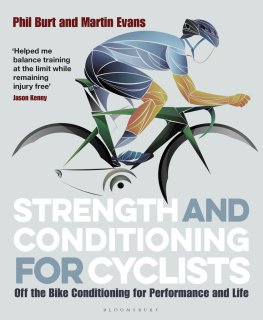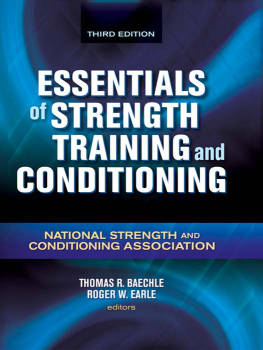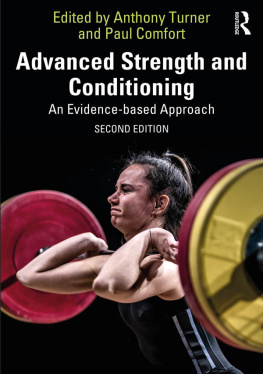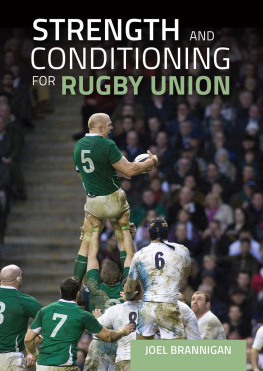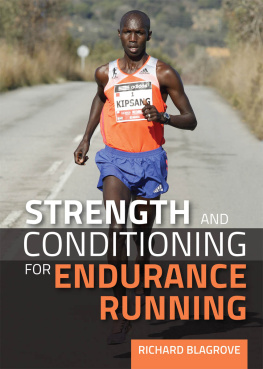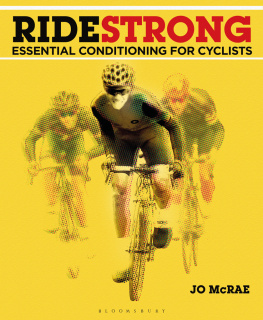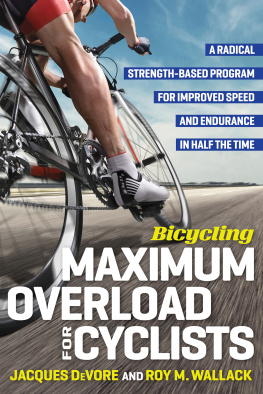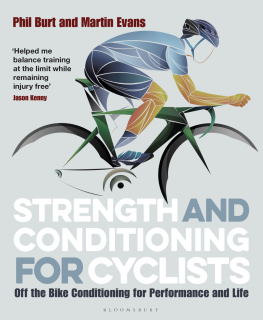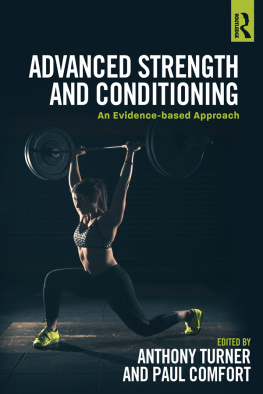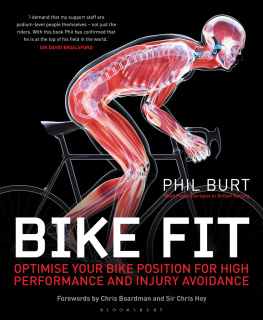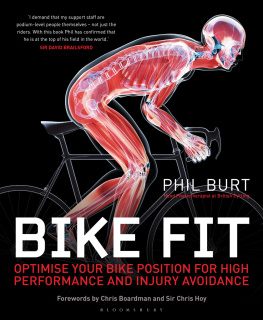Phil Burt - Strength and Conditioning for Cyclists
Here you can read online Phil Burt - Strength and Conditioning for Cyclists full text of the book (entire story) in english for free. Download pdf and epub, get meaning, cover and reviews about this ebook. year: 2018, publisher: Bloomsbury Publishing, genre: Home and family. Description of the work, (preface) as well as reviews are available. Best literature library LitArk.com created for fans of good reading and offers a wide selection of genres:
Romance novel
Science fiction
Adventure
Detective
Science
History
Home and family
Prose
Art
Politics
Computer
Non-fiction
Religion
Business
Children
Humor
Choose a favorite category and find really read worthwhile books. Enjoy immersion in the world of imagination, feel the emotions of the characters or learn something new for yourself, make an fascinating discovery.
- Book:Strength and Conditioning for Cyclists
- Author:
- Publisher:Bloomsbury Publishing
- Genre:
- Year:2018
- Rating:5 / 5
- Favourites:Add to favourites
- Your mark:
- 100
- 1
- 2
- 3
- 4
- 5
Strength and Conditioning for Cyclists: summary, description and annotation
We offer to read an annotation, description, summary or preface (depends on what the author of the book "Strength and Conditioning for Cyclists" wrote himself). If you haven't found the necessary information about the book — write in the comments, we will try to find it.
Strength and Conditioning for Cyclists — read online for free the complete book (whole text) full work
Below is the text of the book, divided by pages. System saving the place of the last page read, allows you to conveniently read the book "Strength and Conditioning for Cyclists" online for free, without having to search again every time where you left off. Put a bookmark, and you can go to the page where you finished reading at any time.
Font size:
Interval:
Bookmark:


B LOOMSBURY SPORT
Bloomsbury Publishing Plc
50 Bedford Square, London,
WC1B 3DP, UK
This electronic edition published in 2018 by Bloomsbury Publishing Plc
BLOOMSBURY, BLOOMSBURY SPORT and the Diana logo are trademarks of Bloomsbury Publishing Plc
First published in Great Britain 2018
Copyright Phil Burt and Martin Evans, 2018
Photos Lucy Sharrett, 2018
Filler images Getty Images
Page 179 (top image) Alex Wright, Ten Eight Photography
Illustration pages , David Gardner
Phil Burt and Martin Evans have asserted their right under the Copyright, Designs and Patents Act, 1988, to be identified as authors of this work
All rights reserved
You may not copy, distribute, transmit, reproduce or otherwise make available this publication (or any part of it) in any form, or by any means (including without limitation electronic, digital, optical, mechanical, photocopying, printing, recording or otherwise), without the prior written permission of the publisher. Any person who does any unauthorised act in relation to this publication may be liable to criminal prosecution and civil claims for damages.
Bloomsbury Publishing Plc does not have any control over, or responsibility for, any third-party websites referred to in this book. All internet addresses given in this book were correct at the time of going to press. The author and publisher regret any inconvenience caused if addresses have changed or sites have ceased to exist, but can accept no responsibility for any such changes
A catalogue record for this book is available from the British Library
Library of Congress Cataloging-in-Publication data has been applied for
ISBN: 978-1-4729-4013-1 (PB)
ISBN: 978-1-4729-4012-4 (eBook)
ISBN: 978-1-4729-4011-7 (ePDF)
To find out more about our authors and their books please visit www.bloomsbury.com where you will find extracts, author interviews and details of forthcoming events, and to be the first to hear about latest releases and special offers, sign up for our newsletters.

CONTENTS
I NTRODUCTION
M any cycling training manuals fall far short of the mark when prescribing off the bike training routines. There are certainly proven performance gains to be had from off the bike conditioning for all cyclists but not in the simplistic way thats often presented.
The problem is that, with one-size-fits-all generic routines, crucial steps in laying the foundations of conditioning are ignored. If you imagine building your fitness as being analogous to building a house, without good foundations any further floors, no matter how well built, are always destined eventually to fail. This failure could be a lack of progress or potentially developing imbalances and injuries. Yes, if you go to the gym and start performing dead lifts and barbell squats, as commonly prescribed in many generic cycling-specific gym routines, youll probably make some apparent strength gains but, without the foundations thatll allow you to perform these movements safely and effectively, those gains are fundamentally compromised and flawed.
BUILDING A STABLE PYRAMID
Cycling fitness, and all conditioning, can be thought of as a pyramid. A pyramid is only stable if it has a broad base with your actual fitness on the bike as just the capstone on the top. At the bottom (Level 1) are general physical qualities. This broad base encompasses range of movement (ROM) and control through that range. For example, when you are lying on your back on the floor, how far can you raise your leg while keeping it straight? If youre unable to elevate it to 75 degrees, youre lacking range of movement through your hamstrings and hips. Now try lowering it. Can you do this under control, without the small of your back leaving the floor? If no, you lack control through the range you have. This in itself may not seem like a big deal but such limitations have major implications on your ability to perform lifts and even to perform movements associated with everyday life. Next (Level 2) are the physical qualities related to cycling but that are not necessarily developed on the bike. These could include maximal power, which you may have enhanced with work in the gym, or a range of motion that allows you to hold an aggressive time trial position. Finally, we come to the top of the pyramid (Level 3) and the cycling-specific fitness that you develop on the bike. Unfortunately, for a huge number of cyclists, including, until fairly recently, top-level elite riders, the capstone was all they really focused on, with little regard for the crucial layers below. Miss or neglect the steps that will develop these foundations, or just ride your bike, and no matter how fast you can cycle, your pyramid is unstable and destined to topple.

Poor form, as demonstrated in these squats, mean that any gains are fundamentally compromised and flawed.

Maximal power, which can transfer to your cycling performance, can be enhanced with gym work.
Another way to think of this is in terms of moderators versus mediators. Moderating factors, such as good strength, optimal range of movement and high levels of adaptability, form that strong stable base of your pyramid. Mediating factors are issues that can lead to injury, breakdown or poor adaptation. Prior injury history or a narrow training focus can be thought of as mediating factors. The interaction between moderators and mediators determines how an athlete will respond to a given training stimulus or block of training. Traditionally, the approach to trying to predict this outcome has been extremely reductionist but, in both studies and when working with athletes, this just doesnt work. An example of this is hamstring tightness, which was viewed as a predictor for injury. Unfortunately, it just doesnt correlate and its possible to have extremely tight but also very strong hamstrings. The reason this reductionist approach doesnt work is that human beings are extremely complex systems. Even with incredible amounts of data and the most powerful supercomputers, were unable to reliably predict the weather more than a couple of days ahead, so how can we even consider trying to apply one-size-fits-all predictions to the equally complex human body? There are just too many moderators and mediators interacting and impacting on the final result of any intervention.

Everyone is different and we like to talk about riders in terms of micro-adjusters and macro-absorbers. Micro-adjusters are those riders who are extremely sensitive to change, can easily slip into a state of maladaptation and are more prone to injury. An example of this type of rider is Ben Swift hell notice the smallest change in his bike set-up and has had to work extremely hard on his off the bike conditioning to improve his resilience. At the extreme macro-absorber end of the spectrum is Geraint Thomas. You can throw the kitchen sink at him in training and hes just able to soak it up. Put him on someone elses bike during a Grand Tour stage and even if the set-up is significantly different to his, he can ride it and hardly notice. At school, there was probably a child you may have been lucky and it was you who was just naturally good at everything. They would be a macro-absorber.
Font size:
Interval:
Bookmark:
Similar books «Strength and Conditioning for Cyclists»
Look at similar books to Strength and Conditioning for Cyclists. We have selected literature similar in name and meaning in the hope of providing readers with more options to find new, interesting, not yet read works.
Discussion, reviews of the book Strength and Conditioning for Cyclists and just readers' own opinions. Leave your comments, write what you think about the work, its meaning or the main characters. Specify what exactly you liked and what you didn't like, and why you think so.

